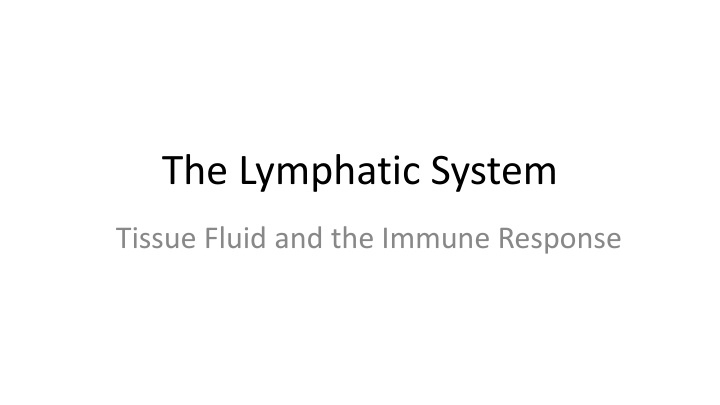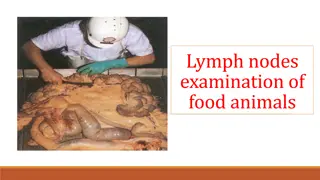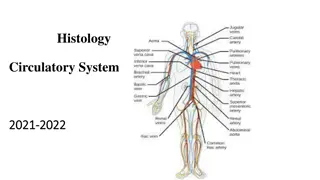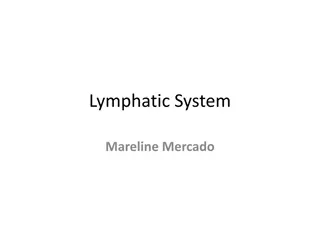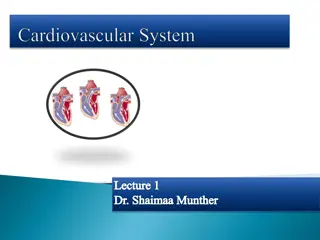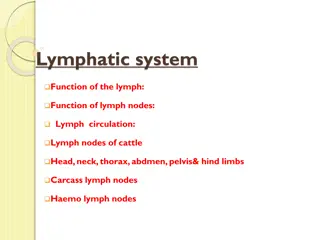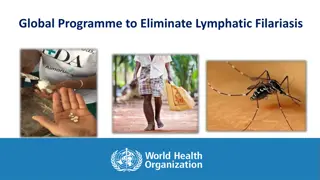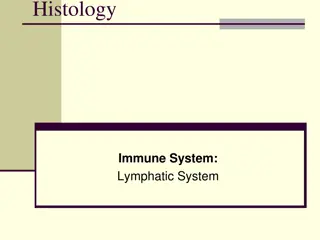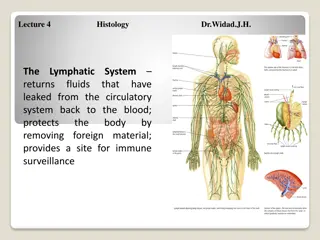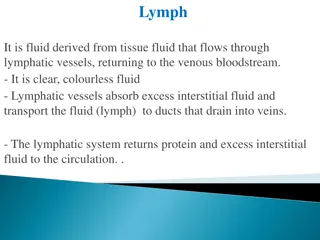The Lymphatic System and Immune Response
The lymphatic system plays a crucial role in draining excess tissue fluid and supporting the immune response to eliminate pathogens from the body. Major structures include lymphatic vessels, nodes, spleen, and thymus. Lymph transports proteins and foreign particles, while lymph nodes filter harmful particles. The thymus is important for T-cell maturation, and the spleen helps with red blood cell disposal and antigen presentation. Mucosa-associated lymphatic tissue (MALT) contains immune cells and encounters antigens in mucosal membranes throughout the body.
Download Presentation

Please find below an Image/Link to download the presentation.
The content on the website is provided AS IS for your information and personal use only. It may not be sold, licensed, or shared on other websites without obtaining consent from the author.If you encounter any issues during the download, it is possible that the publisher has removed the file from their server.
You are allowed to download the files provided on this website for personal or commercial use, subject to the condition that they are used lawfully. All files are the property of their respective owners.
The content on the website is provided AS IS for your information and personal use only. It may not be sold, licensed, or shared on other websites without obtaining consent from the author.
E N D
Presentation Transcript
The Lymphatic System Tissue Fluid and the Immune Response
Functions drain excess tissue fluid not all fluid returns to bloodstream extra enters the lymphatic vessels immune response responds to eliminate pathogens from the body innate and adaptive responses major structures include: lymphatic vessels, lymph nodes, spleen, thymus
Lymphatic Structures lymphatic vessels lymphoid tissues/organs primary or central bone marrow and thymus secondary or peripheral lymph nodes, spleen, mucosal
Lymphatic Vessels similar structure to veins thin with valves unlike veins, they are a one-way street originate as capillaries in the tissues end at the veins
Lymph lymph is tissue fluid that has entered the lymphatic vessels excess tissue fluid functions: transports proteins and other molecules to the bloodstream moves foreign particles to lymph nodes
Thymus located behind the sternum larger in children site of T cell maturation migrate from bone marrow
Lymph Nodes located along lymphatic pathways absent in the central nervous system functions: filter/remove potentially harmful particles before they enter bloodstream immune surveillance (monitoring of fluids by immune cells)
Spleen located in upper abdominal cavity similar to lymph node red pulp (majority of spleen) site of red blood cell disposal white pulp houses lymphocytes site of antigen presentation
Mucosa Associated Lymphatic Tissue (MALT) Lymphatic tissue in the mucosal membranes throughout the body Contains T cells, B cells, and macrophages Can encounter antigens passing through the mucous membranes
Found in several locations in the body Lungs, digestive tract, nasopharynx, skin, breast, salivary glands
Cells of the Immune System broken into two broad groups: myeloid mostly in innate immune system lymphoid adaptive immune system
Myeloid Cells macrophage engulf and kill invading microorganisms can help induce inflammation can activate other immune cells mast cells play a role in allergic responses respond to parasitic worms can induce inflammation
granulocytes neutrophils most numerous phagocytic role in bacterial infection eosinophils and basophils defense against parasites contribute to allergic response can be more damaging than helpful
dendritic cells can take up and degrade pathogens main function is antigen presentation activate cells of adaptive immunity a bridge between innate and adaptive responses
Lymphoid Cells natural killer cells (NK) not part of the adaptive immune system but come from lymphoid lineage not antigen specific can recognize and kill some abnormal cells ex: tumor cells and some viruses thought to keep viruses at bay until adaptive response kicks in
B lymphocytes (B cells) antigen-specific receptors B cell receptors (BCRs) once activated divides to form plasma cells produce antibodies secreted form of BCRs
T lymphocytes (T cells) three categories helper T cells provide signals which initiate responses from other cells cytotoxic T cells kill cells which are infected with a virus or other pathogen regulatory T cells suppress immune activity and help control immune response
The Immune System cells and biochemicals responsible for the surveillance and destruction of non-self innate response quick, non-specific adaptive response slower, specific
Cytokines and Chemokines chemical signaling molecules cytokines proteins secreted which affect behavior of nearby cells pro-inflammatory, regulatory, or growth factors chemokines proteins secreted which attract cells to an area migrate due to a density gradient cells have receptors that bind chemokines
Innate Immune Response macrophages recognize pathogens through receptors engulf and degrade pathogens can present antigens from the pathogen on the surface secrete cytokines and chemokines
inflammation (heat, redness, swelling, pain) recruits proteins and cells to infected areas macrophages and neutrophils increases lymph flow brings microbes and antigen presenting cells (antigen presenting cells APCs) to lymphoid tissues can recruit effectors of adaptive immunity later on
complement pathogens can trigger activation of complement proteins activation begins a cascade which can result in destruction of the pathogen can also promote inflammation
Innate Immune Recognition PAMPs (Pathogen Associated Molecular Patterns) cells (macrophages, neutrophils, dendritic cells) have receptors that recognize simple molecules and regular molecular patterns pattern recognition receptors (PRRs) PAMPs are present on microorganisms but not body cells
Innate and Adaptive innate response initiates adaptive response macrophages engulf pathogens and present antigens to lymphocytes dendritic cells triggered to activate T cells adjuvants bacterial extracts used in vaccines initiate an innate response which in turn activates the adaptive response leads to successful vaccination to the purified protein (antigen)
Adaptive Immune Response initiated by APCs (antigen presenting cells) primarily dendritic cells (but also macrophages) engulf pathogens, degrade, then move the antigen to the surface of the cell dendritic cells also have costimulatory molecules stimulate T cells to proliferate and differentiate B cells usually also require a helper T cell occurs in secondary lymphoid tissues/organs
Proliferation once activated, na ve lymphocytes become lymphoblasts divide to produce clones clonal expansion can divide 2-4 times per 24 hours for about 3-5 days producing about 1000 cells specific to the target antigen these cells become effector cells B cells = plasma cells T cells = cytotoxic or helper T cells
Immunological Memory most cells generated by clonal expansion die some T and B cells are left behind memory cells reactivated quickly when the same antigen is encountered again provides long-lasting immunity
Mechanisms of Adaptive Immunity cell-mediated immune response T cells responsible for destruction of intracellular invaders humoral immunity antibodies detect pathogens in blood and other extracellular fluid (humor = body fluid) other mechanisms are similar to those of innate immunity macrophages, neutrophils, complement
T Cells and Cell-mediated Immunity T cells CD4 = helper T cells CD8 = cytotoxic T cells recognize peptides on MHC molecules (major histocompatibility complex) complex displayed on surface of cells trap peptide during production and transported to surface
MHC class I proteins synthesized in cytosol can display viral proteins recognized by cytotoxic T cells
MHC class II expressed by APCs derived from proteins taken in through phagocytosis/endocytosis activate CD4 cells
stimulated effector cells secrete effector molecules mainly cytokines recruit other effectors to target area CD8 cytotoxic T cells directly kill infected cells recognize antigens CD4 helper T cells can become different types of T cells
TH1 help control bacteria in vesicles of macrophages stimulate them to increase intracellular destruction of bacteria TH2 promote response at mucosal surfaces parasitic infections TH17 promote responses with lots of neutrophils extracellular bacteria and fungi TFH(follicular helper) in lymphoid follicles aid in B cell activation
Antibodies and Humoral Immunity antibody structure secreted B cell receptor two variable regions antigen binding sites almost infinite combination of amino acids constant region 4 or 5 forms determines effector function how the antibody will interact with immune cells to dispose of antigen
antibody actions neutralization binds to antigens and blocks access to cells important in viral infections and against bacterial toxins opsonization coating pathogens with antibodies lead to phagocytosis bacterial infections some evade innate response because they have an outer coat antibodies can recognize the antigens on surface complement activation constant regions can activate the 1stprotein coats surface and enables phagocytosis
antibodies are found in plasma and extracellular fluid antibody mediated immunity is called humoral immunity body fluids used to be known as humors
Immune Responses primary immune response T cells and B cells become activated for the 1st time some memory cells remain secondary immune response if the antigen is encountered again, the memory cells can mount a more rapid attack since they are already present this ability can be long lasting
Practical Classification of Immunity naturally acquired immunity occurs after exposure to the antigen itself artificially acquired immunity occurs through the use of vaccines person does not become ill from the disease artificially acquired passive immunity injection of gamma globulin antibodies (short-lived) naturally acquired passive immunity antibodies are passed from mother to fetus
Vaccines first vaccine developed in 1796 used the cowpox virus to vaccinate against smallpox vaccine comes from the Latin word vaccinus meaning of cows mimic a natural infection immune system responds like it normally would left with a supply of memory T and B cells
Vaccination vs. Immunization vaccination giving of vaccines to prevent disease immunization acquiring immunity against a disease protection against getting sick successful vaccination results in immunization
Types of Vaccines live attenuated vaccines contains live microbes that are weakened so they no longer cause disease elicits an immune response involving memory T and memory B cells drawbacks include: refrigeration there is a risk of mutation of the pathogen which causes disease diseases include measles, mumps, rubella, polio, chickenpox, shingles, flu
inactivated or killed vaccines most common type used today contains pieces of viruses killed with heat, chemicals, or radiation no risk of mutation (since they aren t alive) stimulates B cells to produce antibodies drawbacks include: not as potent as live attenuated booster shots are needed diseases include flu, hepatitis A, polio, rabies
subunit vaccines contain only parts of the microbes that stimulate the immune system mainly the antigens tend to cause fewer adverse reactions diseases include diphtheria, hepatitis B, pertussis, tetanus toxoid vaccines used to combat the toxins produced by pathogens contain inactivated toxin called toxoids stimulate antibody production diseases include diphtheria and tetanus
